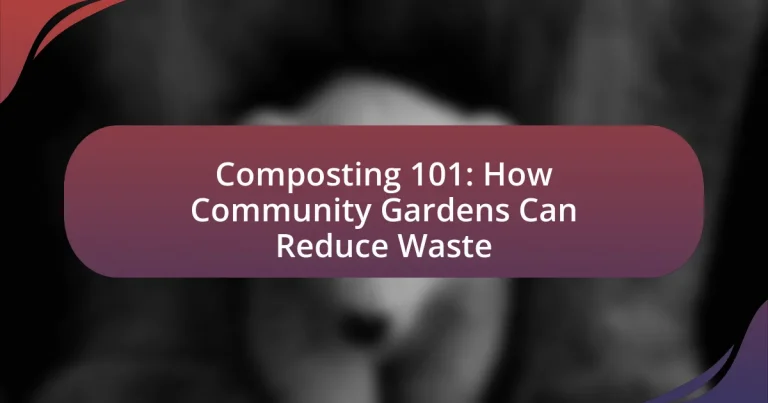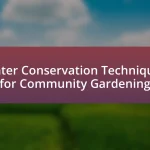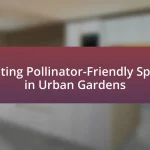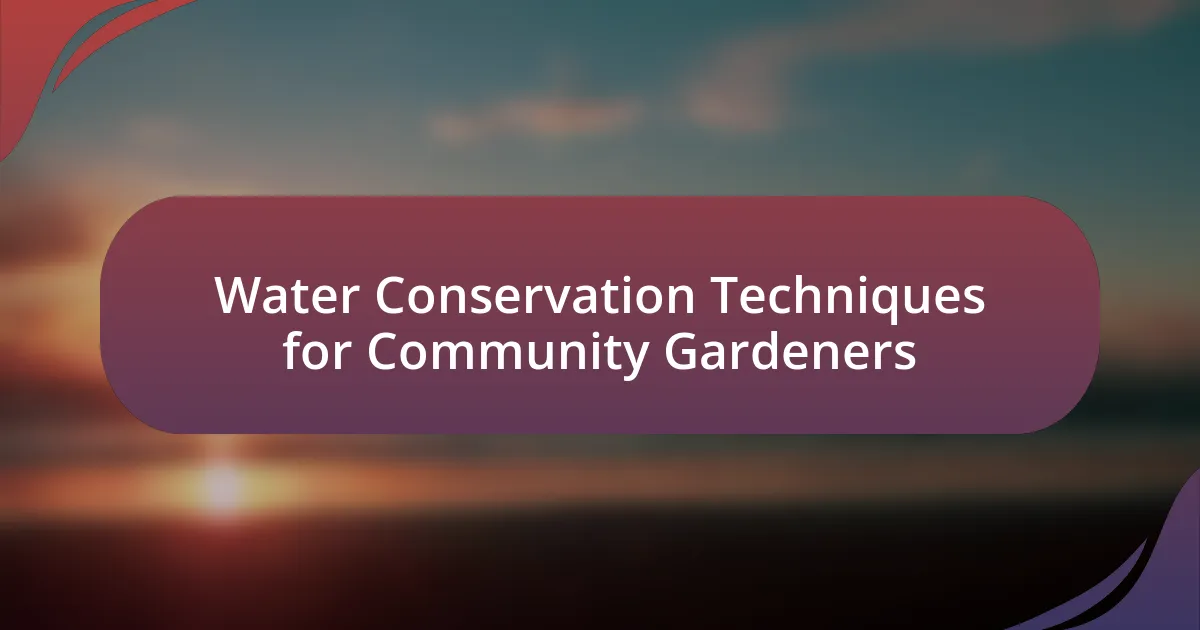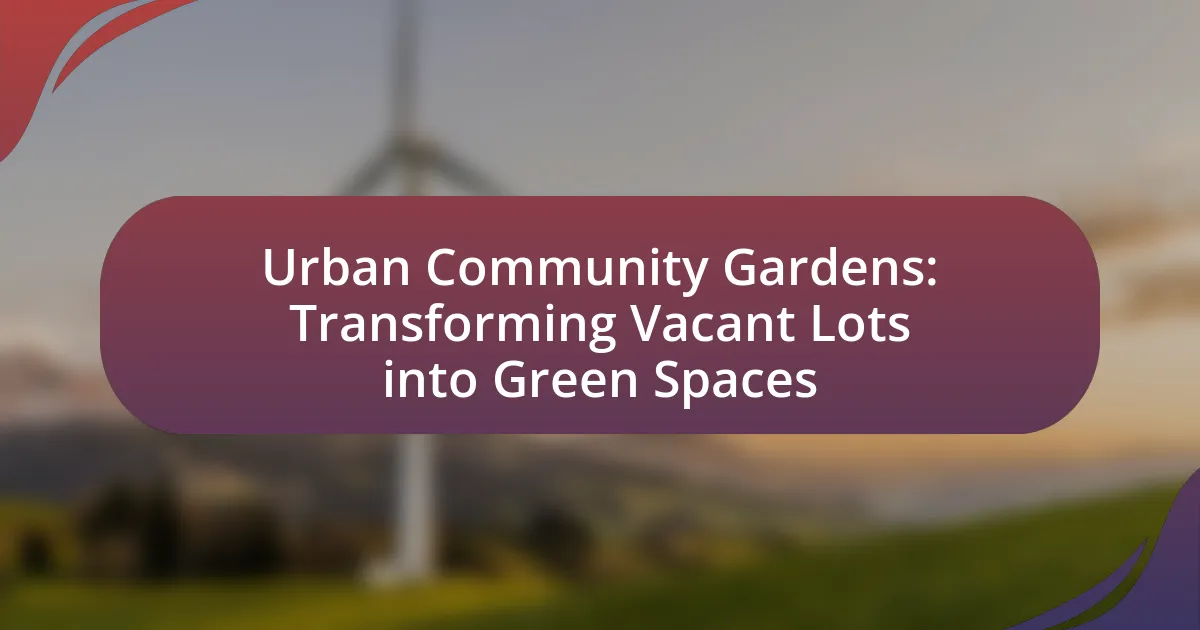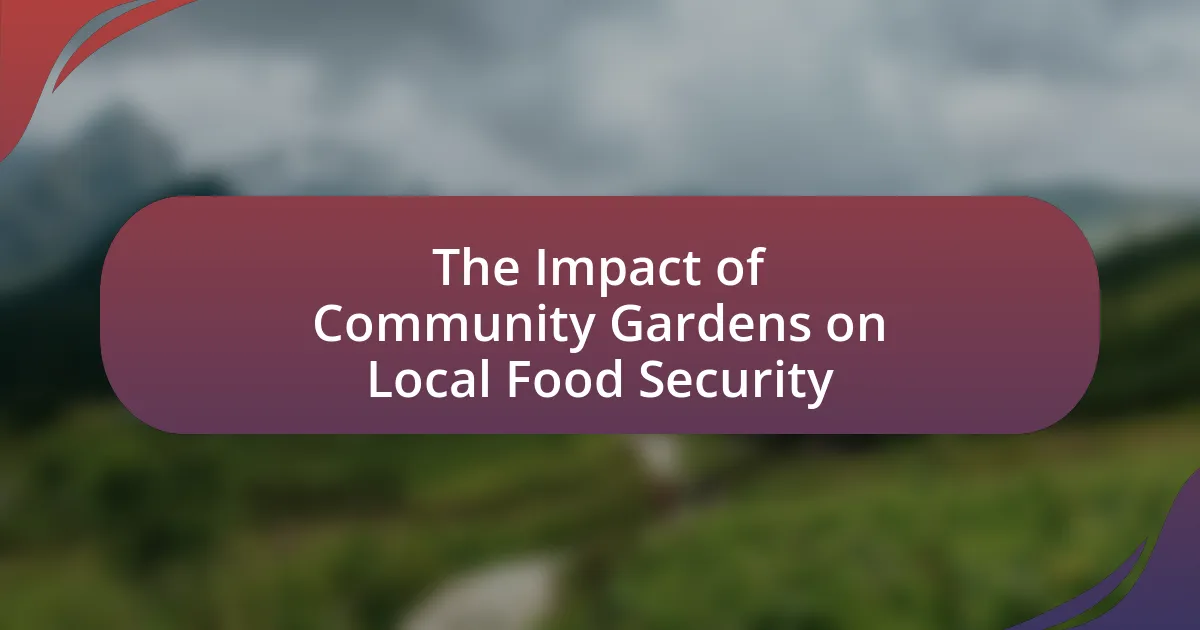Composting is the process of transforming organic waste into nutrient-rich soil amendments, playing a vital role in community gardens by recycling kitchen scraps and yard waste. This practice not only reduces landfill waste by up to 30% but also enhances soil fertility, promoting healthier plant growth and fostering community engagement. The article explores how composting works in community gardens, the types of materials suitable for composting, and the environmental benefits it provides, including waste reduction and improved biodiversity. Additionally, it outlines best practices for implementing and maintaining effective composting systems within community gardens, emphasizing the importance of education and community involvement in achieving sustainable waste management.
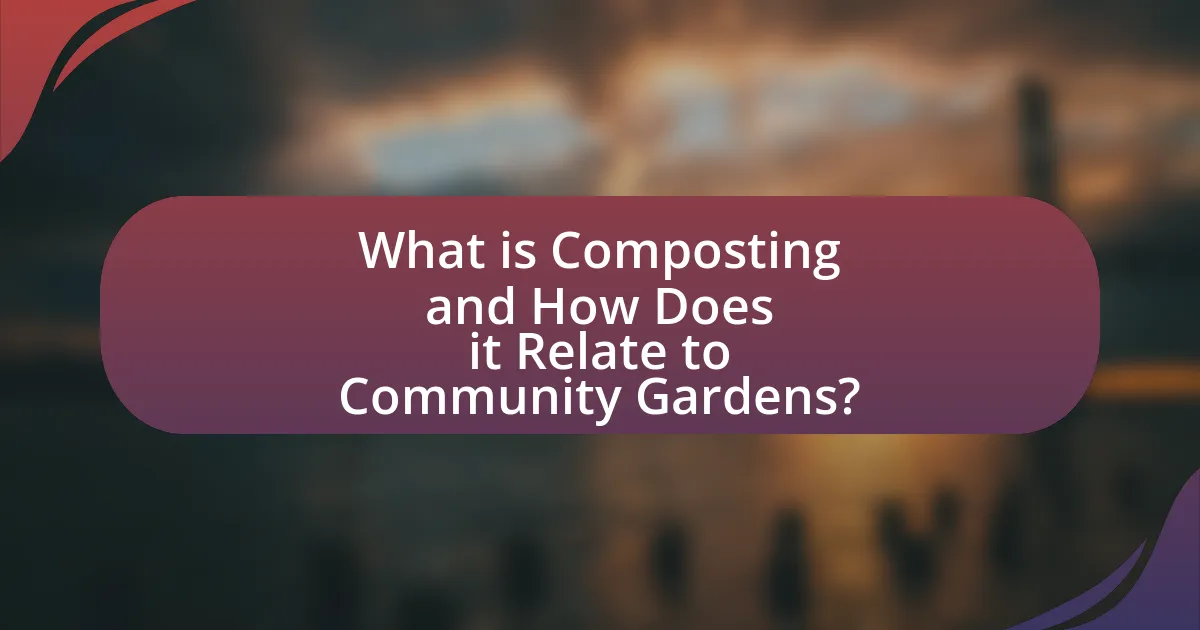
What is Composting and How Does it Relate to Community Gardens?
Composting is the process of decomposing organic waste into nutrient-rich soil amendments through natural biological processes. In community gardens, composting plays a crucial role by recycling kitchen scraps, yard waste, and other organic materials, thereby reducing landfill waste and enriching the soil for plant growth. Studies show that composting can divert up to 30% of household waste from landfills, which is particularly beneficial in community settings where sustainable practices are emphasized. By integrating composting into community gardens, participants not only enhance soil fertility but also foster a sense of community and environmental stewardship.
How does composting work in a community garden setting?
Composting in a community garden setting involves the collection and decomposition of organic waste to create nutrient-rich soil amendments. Community members contribute kitchen scraps, yard waste, and other biodegradable materials to designated compost bins or piles. Microorganisms, such as bacteria and fungi, break down these materials through aerobic decomposition, which requires oxygen.
Regular turning of the compost pile enhances aeration and speeds up the decomposition process. The resulting compost can be used to enrich the garden soil, improve plant health, and reduce the need for chemical fertilizers. Studies show that community gardens utilizing composting can divert significant amounts of organic waste from landfills, promoting sustainability and enhancing local food production.
What materials are suitable for composting in community gardens?
Suitable materials for composting in community gardens include kitchen scraps, yard waste, and certain paper products. Kitchen scraps such as fruit and vegetable peels, coffee grounds, and eggshells provide nitrogen, while yard waste like grass clippings, leaves, and small branches contribute carbon. Additionally, shredded newspaper and cardboard can be composted, as they help balance the carbon-to-nitrogen ratio. These materials are effective because they decompose efficiently, enriching the soil with nutrients and promoting healthy plant growth.
How is compost created and maintained in these gardens?
Compost in community gardens is created by combining organic materials such as kitchen scraps, yard waste, and other biodegradable materials in designated compost bins or piles. The process involves layering these materials to ensure proper aeration and moisture, which facilitates decomposition by microorganisms.
To maintain compost, gardeners regularly turn the pile to aerate it, monitor moisture levels to keep it damp but not soggy, and add carbon-rich materials like dry leaves or straw to balance nitrogen-rich materials like food scraps. This active management accelerates the breakdown process, resulting in nutrient-rich compost that can be used to enrich garden soil.
Why is composting important for waste reduction?
Composting is important for waste reduction because it diverts organic waste from landfills, where it would otherwise contribute to methane emissions. According to the Environmental Protection Agency, organic materials make up about 30% of the waste stream in the United States. By composting, communities can significantly reduce the volume of waste sent to landfills, thereby lowering greenhouse gas emissions and enhancing soil health through the creation of nutrient-rich compost. This process not only minimizes waste but also promotes sustainable agricultural practices, making it a vital component of effective waste management strategies.
What types of waste can be composted effectively?
Organic waste can be composted effectively, including kitchen scraps like fruit and vegetable peels, coffee grounds, eggshells, and yard waste such as grass clippings, leaves, and small branches. These materials decompose naturally and enrich the soil with nutrients. According to the U.S. Environmental Protection Agency, composting organic waste can divert approximately 30% of waste from landfills, thereby reducing greenhouse gas emissions and improving soil health.
How does composting contribute to reducing landfill waste?
Composting significantly reduces landfill waste by diverting organic materials from trash disposal. When organic waste, such as food scraps and yard debris, is composted instead of sent to landfills, it prevents the production of methane, a potent greenhouse gas generated during the decomposition of organic matter in anaerobic landfill conditions. According to the Environmental Protection Agency, composting can reduce the volume of waste sent to landfills by approximately 30%, thereby contributing to more sustainable waste management practices.
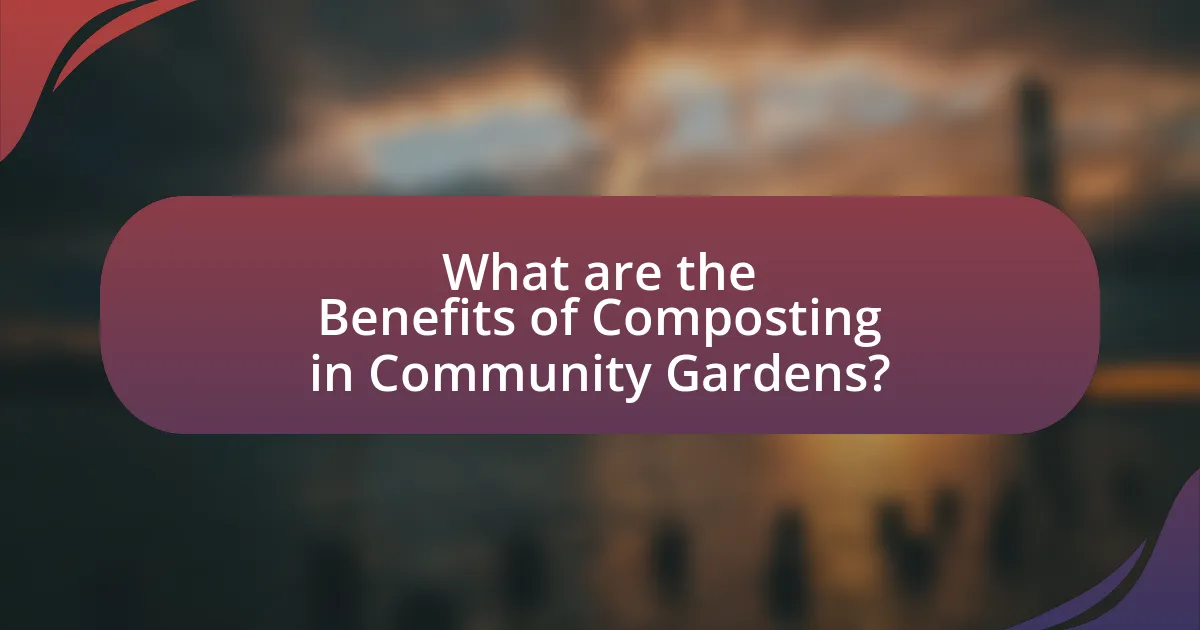
What are the Benefits of Composting in Community Gardens?
Composting in community gardens provides several benefits, including improved soil health, reduced waste, and enhanced community engagement. Improved soil health occurs as compost enriches the soil with essential nutrients, promoting better plant growth and increasing biodiversity. According to a study by the University of California, compost can increase soil organic matter by up to 30%, which enhances water retention and reduces erosion.
Additionally, composting reduces waste by diverting organic materials from landfills, where they would otherwise contribute to methane emissions, a potent greenhouse gas. The Environmental Protection Agency reports that composting can reduce landfill waste by approximately 30%.
Finally, composting fosters community engagement by encouraging collaboration among residents, educating them about sustainable practices, and creating a sense of ownership over shared resources. This collective effort strengthens community bonds and promotes environmental stewardship.
How does composting improve soil health in community gardens?
Composting improves soil health in community gardens by enhancing nutrient availability, increasing soil structure, and promoting beneficial microbial activity. The organic matter in compost enriches the soil with essential nutrients like nitrogen, phosphorus, and potassium, which are vital for plant growth. Additionally, compost improves soil structure by increasing aeration and water retention, leading to better root development and plant resilience. Research indicates that compost application can increase soil microbial diversity, which is crucial for nutrient cycling and disease suppression, thereby fostering a healthier garden ecosystem.
What nutrients are added to the soil through composting?
Composting adds essential nutrients to the soil, including nitrogen, phosphorus, potassium, calcium, magnesium, and sulfur. These nutrients are vital for plant growth and soil health. For instance, nitrogen promotes leaf growth, phosphorus supports root development and flowering, and potassium enhances overall plant resilience. The decomposition process of organic materials in compost releases these nutrients in a form that plants can readily absorb, thus improving soil fertility and structure.
How does composting enhance plant growth and yield?
Composting enhances plant growth and yield by providing essential nutrients, improving soil structure, and increasing moisture retention. The organic matter in compost supplies a balanced mix of macronutrients and micronutrients that plants require for optimal growth. Research indicates that compost can increase soil fertility, leading to higher crop yields; for instance, a study published in the “Journal of Environmental Quality” found that compost application resulted in a 20-30% increase in vegetable yields compared to conventional fertilizers. Additionally, compost improves soil aeration and drainage, which promotes root development and enhances the soil’s ability to retain moisture, further supporting plant health and productivity.
What environmental impacts does composting have?
Composting has several positive environmental impacts, primarily by reducing landfill waste and enhancing soil health. When organic waste is composted instead of sent to landfills, it decreases methane emissions, a potent greenhouse gas produced during the anaerobic decomposition of waste. According to the U.S. Environmental Protection Agency, composting can divert approximately 30% of waste from landfills, significantly mitigating environmental pollution. Additionally, compost enriches soil, improves its structure, and increases its ability to retain moisture, which can lead to reduced water usage in gardening and agriculture. This process also supports biodiversity by fostering beneficial microorganisms and insects in the soil.
How does composting reduce greenhouse gas emissions?
Composting reduces greenhouse gas emissions by facilitating the aerobic decomposition of organic materials, which minimizes methane production. When organic waste is sent to landfills, it decomposes anaerobically, producing methane, a greenhouse gas that is over 25 times more potent than carbon dioxide over a 100-year period. According to the U.S. Environmental Protection Agency, composting can reduce methane emissions by diverting organic waste from landfills, thus promoting a more sustainable waste management practice. By converting food scraps and yard waste into compost, communities can significantly lower their overall greenhouse gas emissions while enriching soil health.
What role does composting play in promoting biodiversity?
Composting plays a crucial role in promoting biodiversity by enhancing soil health and providing essential nutrients for a diverse range of organisms. Healthy compost enriches the soil with organic matter, which improves its structure, water retention, and nutrient availability, creating a conducive environment for various plant species and microorganisms. Research indicates that composting can increase microbial diversity in the soil, which is vital for ecosystem resilience and function. For instance, a study published in the journal “Applied Soil Ecology” found that compost application significantly increased the abundance and diversity of soil bacteria and fungi, which are key players in nutrient cycling and plant growth. This enhanced biodiversity supports a wider array of plant and animal life, contributing to a more balanced and resilient ecosystem.

How Can Communities Implement Composting in Their Gardens?
Communities can implement composting in their gardens by establishing designated composting areas, educating residents on composting practices, and providing necessary materials such as bins and compostable waste collection. Designated composting areas should be easily accessible and large enough to accommodate organic waste from the community. Education can include workshops and informational materials that explain what can be composted, the benefits of composting, and how to maintain a compost pile effectively. Providing bins encourages participation and ensures that residents have a convenient way to dispose of organic waste, which can significantly reduce landfill contributions. According to the Environmental Protection Agency, composting can divert approximately 30% of waste from landfills, highlighting its effectiveness in waste reduction.
What steps are necessary to start a composting program in a community garden?
To start a composting program in a community garden, the initial step is to gather a group of interested community members to form a composting committee. This committee will be responsible for planning and overseeing the composting process. Next, the committee should select a suitable location within the garden that is easily accessible and has adequate drainage. Following this, they need to choose a composting method, such as bin composting or pile composting, based on the available space and resources.
After determining the method, the committee should establish guidelines for what materials can be composted, including green materials like vegetable scraps and brown materials like dry leaves. Education is crucial; therefore, organizing workshops or informational sessions will help community members understand the composting process and its benefits. Finally, regular maintenance of the compost pile or bins, including turning the compost and monitoring moisture levels, is essential to ensure effective decomposition.
These steps are validated by successful community composting initiatives, which have shown that organized efforts lead to effective waste reduction and improved soil health in community gardens.
How can community members be educated about composting?
Community members can be educated about composting through workshops, informational sessions, and hands-on demonstrations. These educational initiatives can be organized by local governments, environmental organizations, or community gardens, providing practical knowledge on composting techniques and benefits. Research indicates that community-based education programs significantly increase composting participation rates; for example, a study by the University of California found that participants in structured composting workshops were 50% more likely to start composting at home compared to those who did not attend.
What resources are available for community composting initiatives?
Community composting initiatives can access various resources, including local government support, educational materials, and funding opportunities. Local governments often provide grants or technical assistance to help establish composting programs, as seen in cities like San Francisco, which has implemented successful composting initiatives supported by municipal funding. Educational resources, such as workshops and online courses from organizations like the Composting Council Research and Education Foundation, offer guidance on best practices for composting. Additionally, non-profit organizations often provide funding and resources to community gardens, enhancing their composting efforts. These resources collectively empower communities to effectively reduce waste through composting.
What challenges might communities face when composting?
Communities may face several challenges when composting, including lack of awareness, insufficient infrastructure, and contamination of compost materials. Lack of awareness can lead to low participation rates, as residents may not understand the benefits or processes involved in composting. Insufficient infrastructure, such as inadequate collection systems or composting facilities, can hinder effective composting efforts. Contamination occurs when non-compostable materials are mixed with organic waste, which can compromise the quality of the compost produced and discourage community involvement. These challenges can significantly impact the success of community composting initiatives aimed at reducing waste.
How can common composting issues be resolved?
Common composting issues can be resolved by maintaining the right balance of carbon and nitrogen materials, ensuring proper aeration, and monitoring moisture levels. For instance, a carbon-to-nitrogen ratio of approximately 30:1 is ideal for effective decomposition, which can be achieved by mixing brown materials like dried leaves with green materials such as kitchen scraps. Additionally, turning the compost pile regularly enhances aeration, promoting microbial activity and speeding up the composting process. Monitoring moisture is crucial; compost should be as damp as a wrung-out sponge, and if it becomes too dry, adding water or moist materials can help restore balance. These practices are supported by research from the University of California, which emphasizes the importance of these factors in successful composting.
What strategies can be employed to encourage participation in composting?
To encourage participation in composting, community engagement strategies such as educational workshops, incentive programs, and accessible composting resources can be employed. Educational workshops inform community members about the benefits of composting, demonstrating how it reduces waste and enriches soil. Incentive programs, such as discounts on gardening supplies for composters, motivate individuals to participate. Additionally, providing accessible composting resources, like designated compost bins in community gardens, simplifies the process and encourages consistent use. Research indicates that communities with active composting programs can divert up to 30% of their waste from landfills, highlighting the effectiveness of these strategies in promoting composting participation.
What are some best practices for successful composting in community gardens?
Successful composting in community gardens involves maintaining a balanced mix of green and brown materials, ensuring proper aeration, and monitoring moisture levels. A balanced mix typically consists of approximately 30 parts carbon (browns like dried leaves and straw) to 1 part nitrogen (greens like vegetable scraps and grass clippings). Proper aeration, achieved by turning the compost regularly, promotes microbial activity essential for decomposition. Additionally, maintaining moisture levels similar to a damp sponge is crucial, as too much or too little water can hinder the composting process. These practices are supported by research from the University of California, which emphasizes the importance of these factors in effective composting.
How can community gardens maintain an effective composting system?
Community gardens can maintain an effective composting system by implementing regular monitoring and management practices. These practices include maintaining a balanced ratio of green materials (nitrogen-rich) and brown materials (carbon-rich), ensuring proper aeration through turning the compost pile, and monitoring moisture levels to keep the compost active. Research indicates that a well-maintained compost system can reduce waste by up to 30%, as reported by the Environmental Protection Agency. Additionally, community involvement in composting education and training can enhance participation and effectiveness, leading to a more sustainable composting process.
What tips can help ensure the composting process is efficient and productive?
To ensure the composting process is efficient and productive, maintain a balanced mix of green and brown materials. Green materials, such as vegetable scraps and grass clippings, provide nitrogen, while brown materials, like dried leaves and cardboard, supply carbon. The ideal ratio is approximately 2:1 of brown to green materials. Additionally, regularly turning the compost pile aerates it, promoting faster decomposition by introducing oxygen, which is essential for aerobic bacteria. Monitoring moisture levels is also crucial; the compost should be as damp as a wrung-out sponge to facilitate microbial activity. These practices enhance the breakdown of organic matter, resulting in nutrient-rich compost in a shorter time frame.
